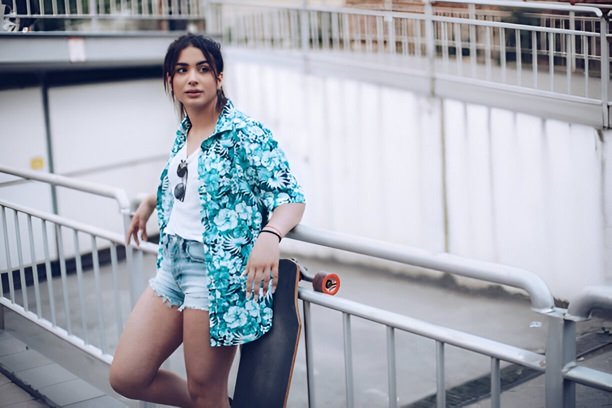Streetwear has evolved from being a niche, underground fashion movement to a global phenomenon with a significant influence on the world of high fashion. Once dismissed by the luxury fashion industry as casual or unrefined, streetwear has broken down the barriers between mainstream fashion and urban culture, blending comfort, self-expression, and rebelliousness into something that has reshaped the aesthetics of high-end brands.
This article explores the rise of streetwear, how it has influenced luxury fashion, and what this cultural fusion says about fashion’s future.
The Origins of Streetwear
Streetwear finds its roots in urban youth culture, born from the streets of cities like New York, Los Angeles, and Tokyo in the late 1970s and early 1980s. Its origins are closely tied to skateboarding, hip-hop, and graffiti scenes, where young people used fashion as a medium for self-expression. Clothing was practical, often oversized, and layered in a way that defied traditional fashion rules.
The pioneers of streetwear brands, such as Stüssy, Supreme, and A Bathing Ape (BAPE), began by designing graphic-heavy T-shirts, hoodies, sneakers, and caps, inspired by subcultural aesthetics. Streetwear appealed to those who sought to distance themselves from the conformity of mainstream fashion and instead embraced counterculture values. It was more than just clothing—it was an attitude, a lifestyle statement.
This grassroots, DIY ethos resonated deeply with young people and allowed streetwear to grow organically through word of mouth, limited releases, and exclusivity. The idea of rarity and “hype” became a central component of the streetwear model, with brands purposefully releasing small quantities to create demand and a sense of community among wearers.
The Rise of Streetwear: From Subculture to Mainstream
Streetwear’s crossover into the mainstream was a gradual process, fueled by the increasing influence of hip-hop and pop culture in the 1990s and early 2000s. Rappers like Jay-Z, Pharrell Williams, and Kanye West became style icons, donning brands like Rocawear, Sean John, and BAPE. This shift brought streetwear into the public eye and legitimized it as a dominant form of youth fashion.
As streetwear brands grew in popularity, they began to collaborate with mainstream sportswear companies like Nike, Adidas, and Puma. These collaborations were pivotal in broadening the appeal of streetwear, combining high-performance athletic wear with urban aesthetics. Sneakers, in particular, became a status symbol, with exclusive drops and limited-edition designs sparking frenzy among collectors and enthusiasts.
Streetwear Meets High Fashion
The fusion of streetwear and high fashion, once considered an unlikely pairing, began to take shape in the late 2000s and exploded in the 2010s. High fashion, long associated with tailored, polished, and elite aesthetics, started to take notice of the power of streetwear’s cultural currency.
Several factors contributed to this convergence:
- Cultural Shifts and Youth Influence
Millennials and Gen Z, who grew up immersed in streetwear culture, began to command significant influence in fashion. These generations placed a premium on authenticity, individuality, and comfort, driving luxury brands to adapt. The idea of exclusivity, a key element of streetwear, mirrored luxury fashion’s traditional focus on rarity and craftsmanship. - Celebrity Endorsements and Collaborations
As celebrities like Rihanna, Kanye West, and Virgil Abloh rose to prominence in both music and fashion, they brought streetwear’s rebellious spirit to the high fashion world. Kanye’s Yeezy line, which started with a collaboration with Adidas, quickly gained traction as a luxury streetwear brand. Meanwhile, Virgil Abloh, founder of Off-White, was appointed artistic director of Louis Vuitton’s men’s collection in 2018, signaling a historic moment where a streetwear designer took the helm of a heritage fashion house. - Collaborations Between Streetwear and Luxury Brands
One of the most significant turning points in streetwear’s influence on high fashion was the groundbreaking collaboration between Supreme and Louis Vuitton in 2017. The collection, which merged Supreme’s urban cool with Louis Vuitton’s luxury heritage, sold out almost instantly and became a cultural moment that cemented streetwear as a legitimate force in high fashion.
Following this success, other luxury brands like Gucci, Balenciaga, and Dior embraced streetwear aesthetics. Hoodies, oversized silhouettes, graphic prints, and sneakers became staples on high fashion runways, blurring the lines between what was once considered casual and what was deemed sophisticated.

Key Elements of Streetwear’s Influence
- Sneaker Culture
Sneaker culture, long a cornerstone of streetwear, has infiltrated the luxury fashion scene in a major way. What was once a subculture of collectors and enthusiasts became a global fashion statement. Luxury brands now produce their own sneakers, often in collaboration with streetwear labels or designers. For instance, Balenciaga’s Triple S sneakers and Dior’s collaboration with Nike have become iconic examples of the merging of streetwear and luxury. - Graphic and Logo-Centric Designs
Streetwear is often synonymous with bold graphics and logos, used not only to brand but also to make a statement. Luxury brands have adopted this element, moving away from subtle logos towards more overt and graphic-heavy designs. The rise of “logomania” in high fashion can be traced directly to streetwear, with brands like Gucci and Fendi embracing large logos on everything from clothing to accessories. - Exclusivity and Limited Editions
Streetwear thrives on exclusivity—limited releases, collaborations, and the elusive “drop” culture, where collections are released in small quantities at specific times. High fashion has embraced this business model, with brands experimenting with capsule collections and exclusive drops to create hype and demand. This shift has changed how luxury fashion markets itself, focusing on creating scarcity and desirability in a similar way to streetwear. - Casual and Comfort-Driven Fashion
The rise of streetwear has coincided with a broader cultural shift towards more casual, comfort-driven clothing. This change is particularly evident in the growing popularity of athleisure and loungewear, both of which have their roots in streetwear. Luxury fashion houses have embraced this trend, incorporating relaxed fits, hoodies, joggers, and oversized outerwear into their collections. Even traditionally formal items, such as tailored suits, have been reimagined with streetwear influences, blending comfort with sophistication.
The Future of Streetwear and High Fashion
As streetwear continues to influence high fashion, the boundaries between these two worlds are becoming increasingly blurred. What was once a clear distinction between casual and luxury is now a fluid continuum where both elements coexist. High fashion has embraced the casual cool of streetwear, while streetwear has gained a level of craftsmanship and prestige once reserved for couture.
Several factors suggest that streetwear’s influence on high fashion is not just a passing trend:
- A Shift in Consumer Values
Today’s consumers, particularly younger generations, value authenticity, individuality, and cultural relevance. Streetwear speaks directly to these values, offering a form of self-expression that resonates with people from all walks of life. High fashion’s adoption of streetwear elements is part of a broader effort to stay relevant in an era where consumers expect more than just luxury—they want fashion that reflects their lifestyles and identities. - Collaboration as the New Norm
The success of collaborations between streetwear and luxury brands has paved the way for more partnerships that push the boundaries of fashion. These collaborations create unique, limited-edition products that capture the attention of both streetwear enthusiasts and luxury consumers. The continued prevalence of collaborations suggests that this dynamic will remain a central part of fashion’s future. - The Democratization of Fashion
Streetwear’s rise represents a broader democratization of fashion, where style is no longer dictated solely by elite designers but by cultural movements and grassroots trends. This shift has empowered consumers to engage with fashion in new ways, blending high-end pieces with streetwear staples to create individualized looks.
Conclusion
Streetwear influence on high fashion represents a cultural revolution in style. What began as a subculture rooted in urban youth movements has grown into a global force, reshaping. The way we think about fashion, luxury, and self-expression. As high fashion continues to embrace streetwear’s aesthetics, the fusion of these two worlds is redefining modern style, breaking down barriers, and creating a more inclusive, dynamic, and fluid fashion landscape.
The impact of streetwear on high fashion is not just about hoodies, sneakers, or logos—it’s about the merging of cultures, the changing values of consumers, and the evolution of fashion into something that is both accessible and aspirational. As streetwear and luxury continue to influence each other, the future of fashion looks set to be more diverse, experimental, and connected to the streets than ever before.











